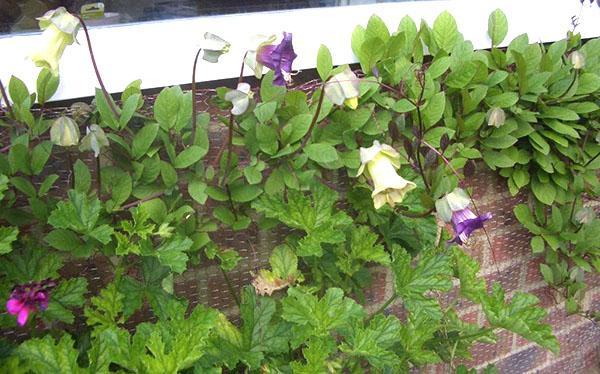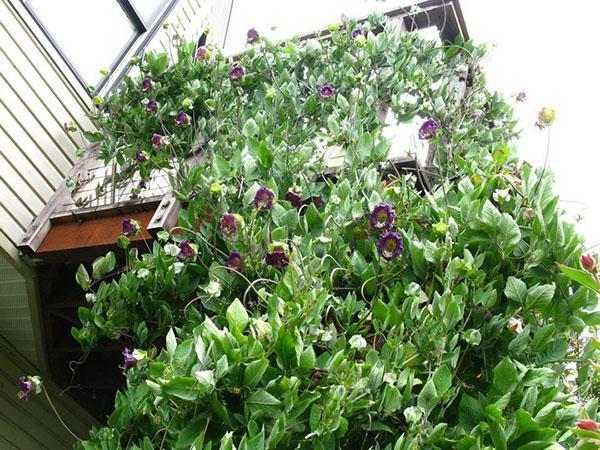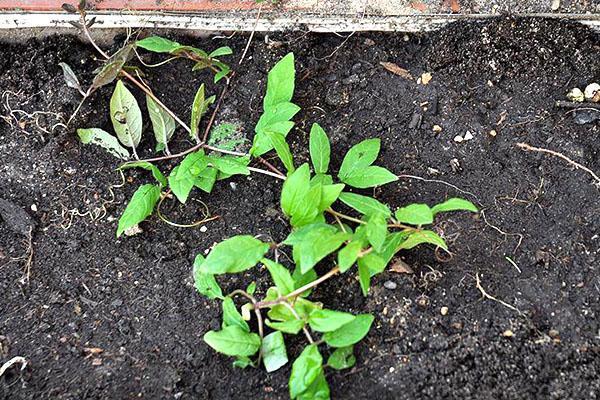An amazing climbing kobea settled in the garden
 Another of the favorite plants of gardeners is the climbing cobea, growing from the seeds of which is somewhat laborious. But the time and effort invested is offset by a gorgeous look and abundant flowering. See photo of clivia!
Another of the favorite plants of gardeners is the climbing cobea, growing from the seeds of which is somewhat laborious. But the time and effort invested is offset by a gorgeous look and abundant flowering. See photo of clivia!
Brief botanical reference

If we talk about natural growing conditions, the plant prefers the humid subtropics and tropics of America. Since 1787, the vine began to be used as an ornamental plant for decorating hedges or gardening gazebos.
Ground requirements
 Growing kobei requires adherence to a number of rules. Only with their scrupulous implementation can you achieve shoots and get suitable seedlings. First of all, let's talk about the soil. For good development, it is necessary to provide the plant with a soft, moderately moist and loose soil. Unfortunately, in the latitudes of Russia, natural conditions are different, so you have to find a way out of the situation by regularly loosening, moisturizing and nourishing the earth.
Growing kobei requires adherence to a number of rules. Only with their scrupulous implementation can you achieve shoots and get suitable seedlings. First of all, let's talk about the soil. For good development, it is necessary to provide the plant with a soft, moderately moist and loose soil. Unfortunately, in the latitudes of Russia, natural conditions are different, so you have to find a way out of the situation by regularly loosening, moisturizing and nourishing the earth.
Seed preparation
 You won't be able to sow seeds just like that - they simply won't sprout. The fact is that the seeds are covered with a hard shell. It is necessary to carry out preliminary preparation: remove it mechanically or simply dissolve to a mucus-like state.
You won't be able to sow seeds just like that - they simply won't sprout. The fact is that the seeds are covered with a hard shell. It is necessary to carry out preliminary preparation: remove it mechanically or simply dissolve to a mucus-like state.
The first step is scarification. To do this, damage the seed shell by rubbing it, for example, with sandpaper. After the seeds are distributed on a damp cloth so that they do not touch each other, they are wrapped and placed in a plastic bag, thereby creating a "greenhouse".
If you have a container that resembles a Petri dish, then you can use that too. A simpler option is a regular plastic container with a lid.
The condition of the seeds is checked daily. If mucus appears on the surface, then it is removed with a cloth, having previously moistened in a weak solution of potassium permanganate. The mucus removal procedure is carried out in several stages. Mold growth indicates that the temperature in the container is too low, so it should be moved to a warmer place. Typically, germination lasts 2 weeks, but in some cases this period is extended to three weeks.
Watch the seeds closely. As soon as they hatch, the seeds are sown immediately. If you are late, the seed pod will simply remain on the plant and then have to be removed by hand, which is fraught with damage to the plant itself.
You can also pre-soak the seeds in special substances - germination accelerators:
- Epin Extra. Soak for 4 hours, preparing a solution of 4 drops of the substance in 0.1 l of water.
- A mixture of honey and aloe juice in equal parts. Duration of soaking 1 hour.
- Zircon. The soaking time is also 4 hours. The solution is prepared from 5 drops dissolved in 0.1 l of water.
Then the seeds are dried and sent to a cloth napkin.
Planting seeds
 In order for the future kobei to be resistant to external influences, cultivation from seeds should be started already at the end of February. To do this, prepare the substrate, pour it into the boxes.Hollows are made in the ground 1.5 cm deep, the seeds are distributed in them with the flat side down, sprinkled with earth and lightly tamped.
In order for the future kobei to be resistant to external influences, cultivation from seeds should be started already at the end of February. To do this, prepare the substrate, pour it into the boxes.Hollows are made in the ground 1.5 cm deep, the seeds are distributed in them with the flat side down, sprinkled with earth and lightly tamped.
The planting can be planted in peat tablets or in individual paper cups, in which it will be possible to immediately plant the young in the ground in bulk.
The soil with the seeds is watered, covered with glass or foil and sent to a warm place, preferably in direct sunlight.
Do not forget to ventilate the greenhouse daily and remove condensation.
Winter sowing
 Often, gardeners, in order to obtain early flowering, plant vine seeds immediately in the ground in July, be sure to carry out all the necessary preparation. At the end of August, the young that appear are dug up, planted in an individual "house" and sent to winter in a cool room, where the temperature does not drop below zero. The ideal temperature for wintering is 8-10 degrees. If it is lower, then the plants are additionally covered.
Often, gardeners, in order to obtain early flowering, plant vine seeds immediately in the ground in July, be sure to carry out all the necessary preparation. At the end of August, the young that appear are dug up, planted in an individual "house" and sent to winter in a cool room, where the temperature does not drop below zero. The ideal temperature for wintering is 8-10 degrees. If it is lower, then the plants are additionally covered.
Watering Kobei exercise in moderation and only when the land is completely dry. If the plants are highly branched in the summer, then they are pruned. At the end of May next year, it will be possible to plant vines in open ground.
With proper cultivation and proper care, the length of the vine can reach 11 meters, and flowering lasts until autumn.
Seedling care
 Watering should be moderate during germination. Can be poured with a growth stimulant. When shoots appear, the box is shaded from direct sunlight. After a while, when the sprouts acquire a couple of leaves, they can already be transplanted.
Watering should be moderate during germination. Can be poured with a growth stimulant. When shoots appear, the box is shaded from direct sunlight. After a while, when the sprouts acquire a couple of leaves, they can already be transplanted.  To do this, the kobei is pulled out together with an earthen lump and transferred into a pot 2-3 times larger than the previous one. This will avoid another transplant and the vine will develop and grow stronger without additional stress.
To do this, the kobei is pulled out together with an earthen lump and transferred into a pot 2-3 times larger than the previous one. This will avoid another transplant and the vine will develop and grow stronger without additional stress.
Be sure to keep track of the volume of the container. In a cramped pot, the liana turn yellow.
After transshipment, it is necessary to finally install a support for each sprout. As for feeding, it should not be carried out, since the vine will not grow and develop, but get confused, which will complicate its further transplant. As soon as the liana reaches a little more than 20 cm in height, it will need to be pinned for the plant to begin to bush.
Landing in open ground
 Transplanting seedlings is possible only when the temperature at night does not drop below 4 ° C. As a rule, this corresponds to the second half of May - early June. Please note that young growth is extremely sensitive to cold, so the grown vine should be hardened before planting. To do this, in the last two weeks before transplanting, they take it out to the loggia, veranda, or in greenhouse... If the temperature continues to fall below zero at night, the plants need to be covered with foil.
Transplanting seedlings is possible only when the temperature at night does not drop below 4 ° C. As a rule, this corresponds to the second half of May - early June. Please note that young growth is extremely sensitive to cold, so the grown vine should be hardened before planting. To do this, in the last two weeks before transplanting, they take it out to the loggia, veranda, or in greenhouse... If the temperature continues to fall below zero at night, the plants need to be covered with foil.
Disembarkation. Option 1
 In a sunny place devoid of wind, dig a hole at least 40 cm deep. Mixing peat, humus and turf soil in equal parts, fill the hole.
In a sunny place devoid of wind, dig a hole at least 40 cm deep. Mixing peat, humus and turf soil in equal parts, fill the hole.
The distance between instances must be at least one meter.
Next, the liana, together with the earthen lump, is pulled out of the container and transferred to the hole, setting it in the very center on a hill of the substrate.
Watering the seedlings, sprinkle with earth, lightly tamp and install a support.
If the seedlings did not emerge at the same time and there are weak plants, they are also planted in the garden, but at the same time they are fertilized with organic matter.
When the night temperature drops, the sprouts are covered with plastic bottles or film. The next 2 weeks are adaptive for plants.
Disembarkation. Option 2
 Also, seedlings can be planted in early May. As a rule, this emergency landing is carried out with overgrown vines. The algorithm is identical to the previous version. But after disembarkation, all loops are neatly distributed over the ground and carefully covered with a dense film. All corners are securely fixed so that the film does not "run away".
Also, seedlings can be planted in early May. As a rule, this emergency landing is carried out with overgrown vines. The algorithm is identical to the previous version. But after disembarkation, all loops are neatly distributed over the ground and carefully covered with a dense film. All corners are securely fixed so that the film does not "run away".
With this method, daily ventilation is important. The creeper will bloom 2 weeks earlier.
At the onset of heat, the "greenhouse" is removed, the lashes are raised and attached to the installed supports.
Further care
 Young growth planted in the ground must be carefully looked after:
Young growth planted in the ground must be carefully looked after:
- Watering is carried out at normal temperature. It should be moderate, and in the heat - plentiful to avoid stunting.
- When weeding, you need to be very careful not to damage the plant. In this regard, the kobea is very capricious.
- As for dressings, they are carried out twice a month in turn: first, mineral is added, and after 2 weeks organic fertilizers... It is especially important to use nitrogen-containing preparations. Top dressing ends at the end of June, otherwise the foliage will "clog" the buds.
- Kobei requires care for the whips. They need to be regularly distributed in the right direction, tied up and yellowed leaves must be removed.

- The soil should be loose and moist. In order not to have to perform these manipulations daily, mulching is carried out with peat, sawdust and humus.
 We examined in detail how to grow a kobei, determined the rules for planting vines, taught you several methods of planting seeds and seedlings. You just have to choose a direction and, moving along it, grow your liana.
We examined in detail how to grow a kobei, determined the rules for planting vines, taught you several methods of planting seeds and seedlings. You just have to choose a direction and, moving along it, grow your liana.  You can additionally familiarize yourself in the video with how the cultivation of a kobei climbing from seeds is carried out.
You can additionally familiarize yourself in the video with how the cultivation of a kobei climbing from seeds is carried out.  If you follow all the tips, you will get a beautiful plant with abundant and long flowering.
If you follow all the tips, you will get a beautiful plant with abundant and long flowering.